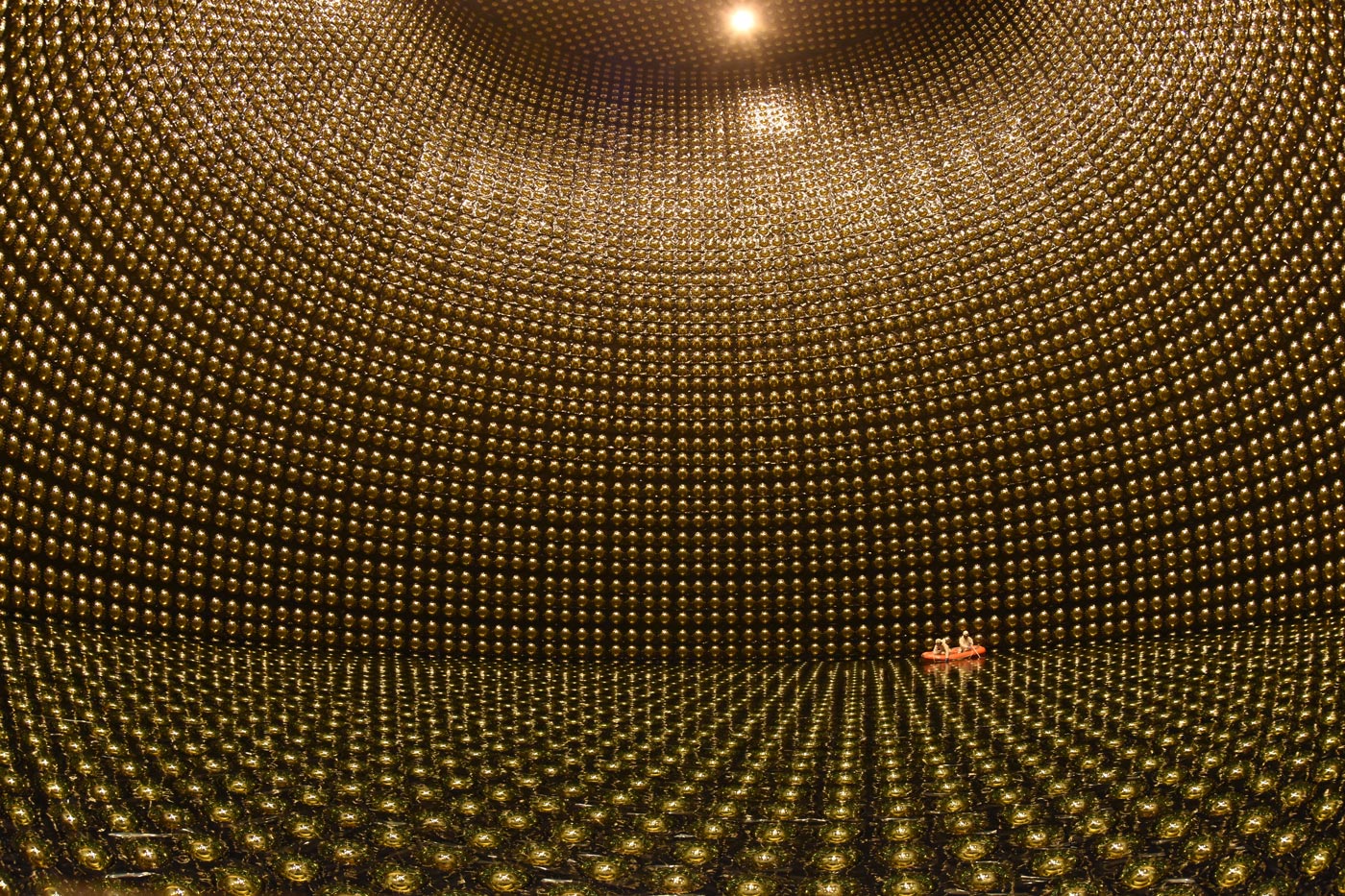CLASH OF THE TITANS
Among physicists, those studying elusive particles called neutrinos may set the standard for dogged determination—or obdurate stubbornness. For 12 years, scientists in Japan have fired trillions of neutrinos hundreds of kilometers through Earth to a gigantic subterranean detector called Super-Kamiokande (Super-K) to study their shifting properties. Yet the nearly massless particles interact with other matter so feebly that the experiment, known as T2K, has captured fewer than 600 of them.
在物理学家中,那些研究被称为中微子的难以捉摸的粒子的人可能为顽强的决心或固执的固执设定了标准。12年来,日本科学家向几百公里外的巨型地下探测器“超级神冈德”(Super-Kamiokande, Super-K)发射了数万亿中微子,以研究中微子的移动特性。然而,几乎没有质量的粒子与其他物质的相互作用是如此微弱,以至于被称为T2K的实验只捕获了不到600个。
Nevertheless, so alluring are neutrinos that physicists are not just persisting, they are planning to vastly scale up efforts to make and trap them. At stake may be insight into one of the most profound questions in physics: how the newborn universe generated more matter than antimatter, so that it is filled with something instead of nothing.
尽管如此,中微子如此诱人,以至于物理学家不仅坚持不懈,而且计划加大努力制造和捕获中微子。关键可能是对物理学中最深奥的问题之一的洞察:新生的宇宙是如何产生更多的物质而不是反物质,以至于它充满了东西而不是什么都没有。
That prospect, among others, has sparked a race to build two massive subterranean detectors, at costs ranging from hundreds of millions to billions of dollars. In an old zinc mine near the former town of Kamioka in Japan, physicists are gearing up to build Hyper-Kamiokande (Hyper-K), a gargantuan successor to Super-K, which will scrutinize neutrinos fired from a particle accelerator at the Japan Proton Accelerator Research Complex (J-PARC) in Tokai 295 kilometers away. In the United States, scientists are developing the Deep Underground Neutrino Experiment (DUNE) in a former gold mine in Lead, South Dakota, which will snare neutrinos from Fermi National Accelerator Laboratory (Fermilab) 1300 kilometers away in Batavia, Illinois.
这一前景引发了一场建造两个大型地下探测器的竞赛,成本从数亿美元到数十亿美元不等。在日本神冈镇附近的一个旧锌矿里,物理学家们正准备建造超级神冈(Hyper-K),这是超级k的巨大后继者,它将仔细检查295公里外的东海日本质子加速器研究中心(J-PARC)的粒子加速器发射的中微子。在美国,科学家们正在南达科塔州铅市的一个前金矿里发展地下深中微子实验(DUNE),它将捕获来自1300公里外伊利诺斯州巴达维亚的费米国家加速器实验室(费米实验室)的中微子。
Researchers with both experiments acknowledge they’re in competition—and that Hyper-K may have an advantage because it will likely start to take data a year or two before DUNE. Yet aside from their goals, “Hyper-K and DUNE are vastly different,” says Chang Kee Jung, a neutrino physicist at Stony Brook University and a T2K member who now also works on DUNE.
两项实验的研究人员都承认他们处于竞争中,Hyper-K可能具有优势,因为它可能会比DUNE早一年或两年开始收集数据。然而,除了他们的目标之外,“Hyper-K和DUNE有很大的不同,”石溪大学的中微子物理学家、T2K成员Chang Kee Jung说。Chang Kee Jung现在也在DUNE工作。
Hyper-K, which will be bigger but cheaper than DUNE, represents the next in a series of ever larger neutrino detectors of the same basic design developed over 40 years by Japanese physicists. It is all but certain to work as expected, says Masato Shiozawa, a particle physicist at the University of Tokyo and co-spokesperson for the 500-member Hyper-K collaboration. “Hyper-K is a more established technology than DUNE,” he says. “That is why I proposed it.”
Hyper-K将比DUNE更大但更便宜,它代表了日本物理学家40多年来开发的一系列更大的中微子探测器中的下一个。东京大学的粒子物理学家Masato Shiozawa说,它几乎肯定会像预期的那样工作。Masato Shiozawa是500名Hyper-K合作小组的联合发言人。“Hyper-K是一项比DUNE更成熟的技术,”他说。“这就是我提出这个建议的原因。”
DUNE will employ a relatively new technology that promises to reveal neutrino interactions in stunning detail and allow physicists to test their understanding of the particles with unprecedented rigor. “Without bragging too much, we are best in class,” says Sergio Bertolucci, a particle physicist at the University of Bologna and Italy’s National Institute for Nuclear Physics and co-spokesperson for the 1300-member DUNE collaboration. However, that technological edge comes with a hefty price tag and, Bertolucci acknowledges, more risk.
DUNE将采用一种相对较新的技术,有望以惊人的细节揭示中微子的相互作用,并允许物理学家以前所未有的严格程度测试他们对粒子的理解。博洛尼亚大学和意大利国家核物理研究所的粒子物理学家塞尔吉奥·贝托鲁奇(Sergio Bertolucci)说:“不用太吹嘘,我们是同类中最好的。”他是1300名成员的DUNE合作组织的联合发言人。然而,贝托鲁奇承认,这种技术优势伴随着高昂的价格和更多的风险。
How the rivalry plays out will depend on factors as mundane as the cost of underground excavation and as exciting as the possibility that neutrinos, always quirky, hold some surprise that will transform physicists’ understanding of nature.
这场竞争将如何展开,取决于一些因素,如地下挖掘的成本等平凡因素,也取决于一种令人兴奋的可能性:永远古怪的中微子可能会带来一些改变物理学家对自然认识的惊喜。
THE MOST COMMON PARTICLES in the universe besides photons, neutrinos exert no effect on the everyday objects around us. Yet they could carry clues to deep mysteries. Neutrinos and their antimatter counterparts both come in three types or flavors—electron, muon, and tau—depending on how they’re generated. For example, electron neutrinos emerge from the radioactive decay of some atomic nuclei. Muon neutrinos fly from the decays of fleeting particles called pi-plus mesons, which can be produced by smashing a beam of protons into a target. These identities aren’t fixed: A neutrino of one type can change into another, chameleonlike, as it zips along at near–light-speed.
作为宇宙中除了光子之外最常见的粒子,中微子对我们周围的日常物体没有任何影响。然而,它们可能携带着解开深层奥秘的线索。中微子和它们的反物质对应物都有三种类型或味道——电子、μ子和tau,这取决于它们是如何产生的。例如,电子中微子产生于某些原子核的放射性衰变。介子中微子从一种叫做π +介子的飞逝粒子的衰变中飞出,这种粒子可以通过将一束质子砸向目标而产生。这些身份并不是固定的:一种类型的中微子可以变成另一种,就像变色龙一样,当它以接近光速的速度快速移动时。
Read more at Science.org
在Science.org阅读更多











